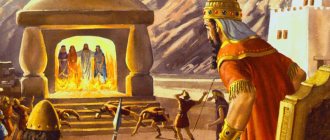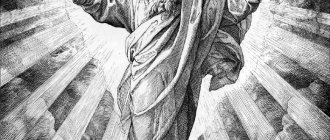In the Orthodox Church, the Gospel is a particularly revered book and is often kept in beautifully decorated covers. Before the Gospel is read, it is usually solemnly carried around the church so that the parishioners can worship it.
The holy book of Christians is the Bible, a collection of texts written by different people at different times. It is divided into the Old Testament and the New Testament. Christians believe that the Old Testament contains the testimonies of God to the Jews, and the New Testament contains the testimonies of people who knew Jesus Christ or were directly involved in the events associated with the birth of the church.
The Bible is said to be “divinely inspired,” that it is “the Word of God,” but there is no complete agreement on how to understand this. Some believe that these are literally the words of God, put into the mouths of different authors, and that every word is true. Others believe that the texts reflect the time in which they were written and the views of the authors, but that overall they contain truth.
New Testament
The second part of the Christian Bible is called the New Testament. These are four testimonies about the life of Jesus Christ, His death and resurrection, called the Gospels. (The word “gospel” means “good news.”) Then follow the Acts of the Apostles, which describe events that took place twenty or more years after the resurrection of Jesus Christ. Paul's wanderings are described in particular detail. Then there are twenty-one epistles of the early church leaders in which they instructed and encouraged the early Christian communities of the Mediterranean. Many of these epistles were written by Paul. Some messages are very short - a page or a little more, others contain many chapters of complex argumentation. They are addressed either to large groups of people or to individuals. The last book of the New Testament is the Revelation of John the Theologian. Traditionally it is attributed to John, one of the closest companions of Jesus Christ. It describes his vision of the end of times (Apocalypse) and the return of Jesus Christ.
The texts that made up the New Testament of the Christian Bible were gradually selected by the early church and established in 380. Many other texts were ultimately not included in the New Testament because they were not considered significant enough. The inclusion of Revelation was undoubtedly hotly debated.
Sacred texts of Judaism
Tanakh (Jewish Bible)
Consists of the Law (Torah), Prophets (Neviim) and Scriptures (Ketuvim); her books were written over a period spanning more than thirteen centuries of Jewish history, from the time of Moses to the last few centuries BC.
1. Torah (Law) The Pentateuch, the so-called Mosaic Law, is the first five books of the canonical Jewish and Christian Bible: Genesis, Exodus, Leviticus, Numbers and Deuteronomy.
2. Nevi'im (Prophets) Includes the books of Joshua, Judges, Samuel, Kings, which tell the history of Israel under the leadership of the prophets, and the books of the prophets Isaiah, Jeremiah, Ezekiel, Amos, Hosea, Micah, Habakkuk, Jonah, Haggai, Zechariah, Malachi and others
3. Ketuvim (Scriptures) Includes the book of Psalms, which are prayers and hymns; Proverbs, the books of Ecclesiastes and Job, containing sayings, discourses on wisdom and reflections on human existence; The Lamentations of Jeremiah, telling of the destruction of the Jerusalem Temple; the love poem Song of Songs, which has long been interpreted as a description of the mystical relationship between God and Israel or between God and man; the book of the prophet Daniel, which tells about faith in times of persecution.
Talmud
In addition to the Tanaka, there was a tradition of the Oral Torah, which existed among the rabbis in the first centuries of our era and was codified as the Talmud.
It consists of two main parts - the Mishnah and the Gemara - and carries enormous authority for the observant Jew.
The Talmud can also be regarded as the development of the tradition of commenting on the text of the Bible for its correct understanding. Although most of the Talmud is devoted to the interpretation and codification of the Law, there are passages in it that have the character of universal spiritual and ethical wisdom. The best known in the Talmud is a small treatise called Abot, or Sayings of the Fathers, relating to the Mishnah. The books of Midrash (rabbinic commentaries on scripture) are rich in moral and spiritual teachings and stories.
Rabbinic texts
Other rabbinical texts of the same period also enjoy great authority among devout Jews: Sifra , which includes the Numbers of Sifra and Deuteronomy Sifra, Tanchuma, Pesikta Rabbati and Pesikta Kahana, Tosefta .
Kabbalah
In addition to them, the books of prayers established by the Law attract attention in the Jewish tradition. Mystical treatise. The Zohar and a number of other writings form the Kabbalah, a mystical tradition that has canonical significance for many Jews.
Theological treatises
A number of theological treatises are also of great importance, among which are about Moses Maimonides (1135-1204) and “Shulchan Aruch” by Joseph Karo (16th century).
Other texts
Most Christians draw inspiration from the Old and New Testaments. However, other texts have been used for teaching and devotional meditation for many centuries. Although the Bible is the center of Christian teaching, there is a tradition of interpreting and analyzing material not included in the Bible, as well as writing new texts. Christian literature also includes the lives and teachings of saints and testimonies of visions, as well as prayers and doxologies.
Bible translations. The original language of the Old Testament is Aramaic (Hebrew), and that of the New Testament is Greek. The Hebrew Bible was translated into Greek before our era, and early Christians knew the Greek version. By the end of the second century AD, translations had been made into Syriac and Latin, and later translations into many other languages appeared. The first complete translation of the Bible into English appeared at the end of the fourteenth century.
Share link
The Bible is the holy book of Christianity
The most important and at the same time the most revered book of all Christians is the Bible. It is one of the most outstanding monuments of world religious thought.
At the same time, it is also a valuable historical source.
The name “Bible” was assigned to the holy book of Christianity in the 4th century
.
the Patriarch of Constantinople John Chrysostom
first called it The Bible was compiled over almost fifteen hundred years.
It began around the 12th century BC.
Well, its creation ended already in the second century AD.
The Bible consists of two parts,
called
the Old and New Testaments.
The first part of the Holy Scriptures was created even before the emergence of Christianity
in the Hebrew language.
While
the second part is in ancient Greek
.
A little later, the Old Testament was also translated into Greek. This was the world's first literary translation. It makes up almost four-fifths of the entire book. In addition to Christians, Jews also recognize it. The Old Testament includes thirty-nine books
that are considered canonical and eleven books that are protocanonical.
They describe stories about the creation of the world, the great flood, the expulsion of people from paradise and much more. Christianity accepted the canonized ideas of the Old Testament, while completely rejecting their interpretations. The New Testament embodied the basic ideas of Christian doctrine.
Structurally, this part of the holy book is divided into
four Gospels
.
The first three from Matthew, Mark and Luke
are synoptic, since they describe events as if from one point of view.
There is a special form of presentation in the Gospel of John.
The Gospel of Mark is considered the oldest, although it is located after the Gospel of Matthew.
The author devoted four chapters of his book to the death of Jesus Christ. He also paid special attention to the execution of John the Baptist. The other Gospel of Matthew is much larger in volume. It is written from a Jewish-centric perspective. He describes Jesus as a greater than Moses—the savior of the Jewish people. But, nevertheless, the Magi in the book come to the Messiah from the East, which shows that he is the savior of the whole world, and not just one people. In his story, another evangelist, Luke, places more emphasis on the goodness of Christ. In the holy book he describes his compassion for women, the poor, the crippled. The main theme of the Gospel of John is the miracles performed by the Son of God, which he calls signs. These are the miracles of the resurrection of Lazarus, the healing of the blind and others. Jesus himself becomes, as it were, a guide, a door to something higher, true. In addition to the four Gospels, the New Testament also includes the Acts of the Holy Apostles
, various Epistles of the Apostles and a prophetic book called the Apocalypse.
In the process of creating the holy book, many works of Christian theologians were not included in the final version of the Bible. But, despite this, they continue to exist among Christianity. Such books are called apocrypha.
The Apocrypha, like Holy Scripture itself, is divided into two parts.
The first, Old Testament ones include the book of Enoch, the Testaments of the twelve patriarchs, some versions of the book of Genesis
and others.
The New Testament apocrypha includes the Proto-Gospel of James, the Gospel of Truth, and the Gospel of Thomas.
This list also includes the Gospels of different ethnic groups and religious Christian leaders not recognized by the official Church.
Most apocrypha are prohibited for Christians. But some of them, which do not directly contradict the basic church dogmas, are nevertheless permitted. These include, for example, the Psalter, the Gospel of the Birth of Mary
and others.
The Bible is the most holy book for all Christians.
This same book is a source of inspiration for many artists.
It has been translated into almost all known languages
, and is the most widely circulated edition of the book in the world.
Read the Book
In the centuries-old history of the development of writing. The Bible has a special place. Perhaps this is the only book around which, over the centuries, controversy has not subsided, but intensified. The intransigence is striking, the super-chlivis in his views on. The Bible, the range of assessments of its content: from the unconditional worship of the overwhelming number of believers, to the satirical interpretation of the texts by freethinkers and atheists.
Unfortunately, in the former. THE USSR. Few people know the Bible. The nihilistic attitude towards this cultural and historical phenomenon, instilled by official propaganda, made it “forbidden” and practically unattainable for the majority of the community.
In modern conditions, when... The Bible has become accessible and has been talked about at different levels and in different forms; the conversation about it should be put on a scientific basis. Currently, commentary literature on issues of philosophy, sociology, psychology and religious studies has lost the authority that it had before. The politicization and ideologization of science has led to the fact that it has lost its objectivity in favor of a class or party position. But historical practice shows that without such literature it is impossible to move forward. Why? Both should evaluate them from the standpoint of today’s achievements.
Biblical studies is a science that has more than 2000 years of history. Many books have been written, both apologetic and critical. Writing an objective book about. The Bible was hampered by the fact that it is the sacred book of two religions - Judaism and Christianity. As you know, these religions have different directions, sects that interpret many of the provisions of the religion differently. The Bible, therefore their analysis is of a purely confessional nature, where provisions are interpreted to suit one direction or another. Bible. The analysis of biblical texts by freethinkers and atheists led to the other extreme: they set themselves the task of debunking. B the Bible, because they were looking only for contradictions. However, the truth is somewhere in the middle - in scientific analysis as content. The Bible and its historical functioning.
Difficulties that study causes. The Bible is that. The Bible is not a historical monument, but a book that actively functions in the modern world. Therefore, it is much easier to analyze the texts of the sacred books of ancient literature than biblical literature, since they do not affect our interests. During analysis. The Bible should be approached not so much as a historical landmark, but as a socio-historical phenomenon.
The word “Bible” itself has great authority among the population. We have had an unspoken ban for over 70 years. The Bible aroused even greater interest. If we compare the interest in the Bible in Western countries. RAMS and here, we can say with confidence that in our country it is much higher. Religious centers estimate that millions of copies are needed to satisfy demand. Bible.
Sociological analysis among believers and non-believers showed that. The Bible is a book that everyone has heard about, but almost no one has read or analyzed. Among various religious movements, attitudes towards the Bible are not the same: for example, Catholics were forbidden to read for a long time. Even now it is not recommended to read the Bible without a priest; In Orthodoxy there was no official ban, but study was not recommended. Bibles outside of Sunday schools or other religious institutions; in Protestantism, everyone must independently study and be able to interpret. Bible.
Therefore, depending on the confessional affiliation, firstly, believers know. The Bible in different volumes, secondly, they know. The Bible selectively from the catechesis that they underwent and are undergoing now (Catechism - a statement of the fundamentals of Christian doctrine in the form of questions and answers.
Statements from different people about. Bibles are often diametrically opposed
As the analysis shows, in our country the biblical culture of the population is very low
What an assessment. Bibles were and are given by theologians, secular people and atheists?
For example, in the textbook for evangelical Christian Baptists “Introduction c. Old and The New Testament states: “The Bible is the only book in the world that indicates the purpose of the universe. The history of the struggle around. B. The Bible shows the complete powerlessness of low-quality human criticism to undermine trust in the word. God, since true science finds nothing in. The Bible, in order to refute it, but on the contrary, confirms it, is compiled into neither texts.”
In the journal. The Moscow Patriarchate states that the Christian religion is based on. Saint. Bibles, science - on the study of nature. The Bible and nature are two books written. God and intended for reading. Anna to a person, as a work of the same author, they cannot contradict each other.”
In the Children's room. Bible" states: "The Bible is the word. God's. It reveals the secret of the origin of the world, man and the meaning of existence."
At the same time, freethinkers and atheists have been deprived of all times. Holy halo Bible and showed its earthly foundations
“Every era,” he wrote. LFeuerbach, reads from. The Bible only itself, each era has its own, amateur. Bible"
So,. A. Bebel in the book “Christianity and Socialism” wrote: “Not a single book in the world has driven so many people to madness as. Bible. Poor thinkers were looking for something in it that was not really there, and when it seemed to them that they had finally found the truth, they came across something that contradicted the previous one and was incompatible with it.”11 Skvortsov-Stepanov emphasized: “The holy books of all religions Believers still remain saints. When approaching them, the believer experiences reverence and awe from the very beginning. He cannot and does not want to understand - he is touched. Only those places that his mind is reach his mind: his opinion glides through incomprehensible and inappropriate places, without clinging to them. Therefore, they do not cause doubts, protests or objections to the list among believers.”
Historically, for many centuries. The Bible influenced the “spiritual climate” of Europe and determined the overall European development of culture. Assessing its cultural and historical phenomenon. Gorky wrote: “The Bible is a book of high artistic value; when using it, one must preserve its high pathos, purity of language.”
Followers of various religious Christian movements claim that the study. The Bible is impossible without faith. This of course does not mean that a non-believer cannot read and understand. The Bible. This means that people who do not believe in believers, as religious preachers believe, will not be able to understand faith, and through this. Bible.
For centuries, “faith” was only a religious category, but social practice shows that it is not so much a person’s attitude to religion as its socio-psychological state. It is impossible to imagine a person who does not believe in anything. Even a nihilist believes in his unbelief. Let's take, as an example, the process of cognition. Each of us studied some discipline, and it is safe to say that we took 99 percent of our knowledge on faith. It turns out that there is no difference between scientific and religious faith? niya, which distinguishes scientific faith from religious faith.
One of the most authoritative theologians. Russian Orthodox Church priest. Omena in his book “How to Read.” Bible" wrote: "To those who are beginning to get acquainted with... Sacred. Scripture, you don’t need to read it in a row, like an ordinary book. It's better to start from. Gospel, return to it again after reading. The Old Testament (or its main parts) and only then to Acts. Messages and. Apocalypse. The Gospel is essentially understandable to everyone; in addition, numerous interpretations and commentaries help in reading it. The Old Testament is older and more difficult to understand. Theologians, by the way, recognize that the content. The Bible does not have the same value.”
The XX century is marked by a special spread. Bible. Spreading. The Bible has especially grown during our century. By translations into other languages. The Bible ranks first in the world. More than five hundred years ago, even before the advent of printing. The Bible or its individual books (sections) have been translated into 33 languages. By 1804 - the beginning of the birth of Bible societies, translated. The Bible was only in 67 languages. But the draft is a drag
XIX century it was already published in more than 400 languages, and during
XX century The Bible and its individual books have been translated into another 1,400 languages. Thus, at the end of the 80s, the number of languages into which it was translated. The Bible, dating back to 1907, is complete with them. The Bible has been translated into 310 languages. New Testament - - in 695 languages and at least one or more books. Bibles - in 902 languages. Today, only about 2% of the world's population does not own a single book. Bibles in your native language. It should be added that books. The Bible is also recorded on records, cassettes and they are manuals for the illiterate and blind. In this form. The Bible became available to people in another 400 languages and dialects. Besides,. The Bible is issued for the blind in raised dotted font volume. Braille 84 languages 4 languages.
The Bible also ranks first in the world in terms of circulation. For comparison: in 1900 it was issued. Bibles - 5 million and. New Testaments - 7 million, and in 1980 -. Bibles - about 36 million. New Testaments - 57 million and a few million more individual books. Bible. Bibles.
Therefore study. The Bible, in our opinion, should be divided into several stages. This is the knowledge of that historical, ideological, scientific, religious era when the biblical texts were written, secondly, the study of the content of the religious books themselves, and thirdly, finding out how these books influenced various aspects of human activity.
Relying on the. The Bible, Christianity produced its own view of the world in which we live, of our place in this world, of the activities of a believer to achieve the “kingdom of heaven.” In this way, religious consciousness is qualitatively different from other forms of social consciousness; none of them can oppose yourself religion. Therefore, such a search for opposition between religion and the religious-idealistic worldview in atheistic literature.
Previously, there was almost no talk about the positive role of religion, but now it shows that the religious is positive in the history of mankind
Now the pendulum has moved to the right. Truth is on the side of religious extremists, not on the side of militant atheists
The purpose of this book is to provide understanding. The Bible and its role and place in cultural history








